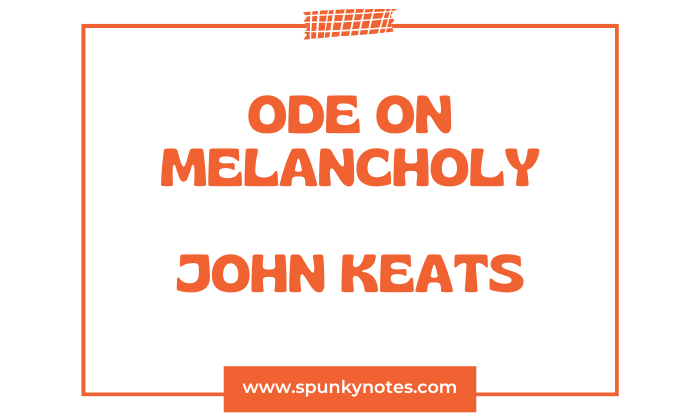

Estimated Reading Time: 10 min
Q. Critically analyse the Ode on Melancholy by John Keats.
Analysis of Ode on Melancholy by John Keats
Stanza 1
No, no, go not to Lethe, neither twist
Wolf’s-bane, tight-rooted, for its poisonous wine;
Nor suffer thy pale forehead to be kiss’d
By nightshade, ruby grape of Proserpine;
Make not your rosary of yew-berries,
Nor let the beetle, nor the death-moth be
Your mournful Psyche, nor the downy owl
A partner in your sorrow’s mysteries;
For shade to shade will come too drowsily,
And drown the wakeful anguish of the soul.
No, no, go not to Lethe, neither twist
Wolf’s-bane, tight-rooted, for its poisonous wine;
Nor suffer thy pale forehead to be kiss’d
By nightshade, ruby grape of Proserpine;
John Keats starts by advising against seeking oblivion in forgetfulness or death. “Lethe” is a river in Greek mythology whose waters cause forgetfulness among the dead.
“Wolf’s-bane,” a poisonous plant, is discouraged from use due to its deadly nature. Keats also warns against embracing “nightshade,” another toxic plant depicted as the “ruby grape of Proserpine.”
In mythology, Proserpine (or Persephone) is the underworld queen, linking Nightshade to death and the afterlife. These references collectively discourage turning to death or forgetfulness as escapes from sorrow.
Make not your rosary of yew-berries,
Nor let the beetle, nor the death-moth be
Your mournful Psyche, nor the downy owl
A partner in your sorrow’s mysteries;
In this passage, Keats advises against adopting symbols of death as tokens of mourning. “Yew-berries,” associated with graveyards, should not be fashioned into a “rosary,” a string of beads used for prayer, suggesting not to dwell morbidly on thoughts of death.
He continues, advising against making creatures like the “beetle,” “death-moth,” and “downy owl” companions in grief. These creatures are often linked with night and decay.
“Downy” means soft and fluffy, like the feathers on young birds or beneath the exterior feathers of many birds.
The downy owl symbolizes a creature of the night, known for its silent flight and solitary nature, which Keats cautions against making a companion in one’s private sorrows.
“Psyche” refers to the human soul or spirit, especially its emotional depth and sensitivity. When Keats mentions “Your mournful Psyche,” he talks about the individual’s soul experiencing sorrow.
The use of “Psyche” in this way draws from Greek mythology, where Psyche is a mortal woman whose love story with Eros (Cupid) symbolizes the soul’s journey through trials and tribulations toward ultimate happiness.
In “Ode on Melancholy,” the reference to the soul as “mournful” emphasizes the inherent ability of the human spirit to feel and deeply experience sadness.
Keats highlights that melancholy, or profound sadness, is fundamental to the human condition. The soul’s mourning is not just about feeling sad but about the depth of feeling that sadness can evoke.
For shade to shade will come too drowsily,
And drown the wakeful anguish of the soul.
Keats concludes the stanza by cautioning that surrendering to despair and seeking refuge in darkness (“shade to shade”) will only lead to a lethargic dulling of the soul’s pain.
This approach, he suggests, risks numbing the “wakeful anguish of the soul”—the acute awareness of one’s suffering—without truly addressing or alleviating it.
The imagery conveys that while darkness may temporarily obscure sorrow, it ultimately does not provide relief or understanding, instead deepening the sense of loss and disconnection from life.
Stanza 2
But when the melancholy fit shall fall
Sudden from heaven like a weeping cloud,
That fosters the droop-headed flowers all,
And hides the green hill in an April shroud;
Then glut thy sorrow on a morning rose,
Or on the rainbow of the salt sand-wave,
Or on the wealth of globed peonies;
Or if thy mistress some rich anger shows,
Emprison her soft hand, and let her rave,
And feed deep, deep upon her peerless eyes.
But when the melancholy fit shall fall
Sudden from heaven like a weeping cloud,
Keats compares the sudden onset of a melancholy mood to a rain cloud suddenly releasing its burden with overwhelming intensity.
This image likens the onset of sorrow to a natural, albeit sudden, phenomenon, suggesting it is as natural as weather changing.
That fosters the droop-headed flowers all,
And hides the green hill in an April shroud;
Though initially seen as unfavourable, the melancholy is depicted as nurturing to “droop-headed flowers,” indicating that sorrow can bring nourishment and growth, much like rain revives wilted plants.
“Shroud” typically refers to a cloth used to wrap or cover something, often associated with the cloth used to wrap a body for burial.
‘Shroud” is used metaphorically to describe how a hill is covered or obscured. This could be by mist, fog, or perhaps even a bloom of flowers that changes its appearance.
The “April shroud” specifically suggests a covering related to spring, which could involve elements like spring showers, mists, or even the lush growth of new plants and flowers that partially conceal the hill’s usual greenery.
Then glut thy sorrow on a morning rose,
Or on the rainbow of the salt sand-wave,
Or the wealth of globed peonies;
The phrase “Then glut thy sorrow on a morning rose” from John Keats’s “Ode on Melancholy” offers advice for dealing with sadness by suggesting that one should immerse oneself fully in the beauty of a rose seen in the morning light.
The word “glut” implies a deep indulgence or satisfaction, indicating that one should observe and fully engage with this beauty to address their sorrow.
The “morning rose” symbolizes beauty’s delicate and ephemeral nature, highlighting life’s transient yet powerful moments.
“Or on the rainbow of the salt sand-wave” from John Keats’s “Ode on Melancholy” is about finding peace by noticing nature’s beautiful, short-lived sights.
This describes the beautiful moment when sunlight hits the ocean waves perfectly, making rainbow colours appear over the water.
It captures a short but amazing scene at the beach, with waves crashing and the salty air mixing with sunlight to create these colourful hues.
Keats tells us that these quick, beautiful moments, like seeing a rainbow on the water, can help us feel better when we are sad.
Keats points to the rich, lush beauty of peonies, which are often large, spherical flowers full of petals, to suggest indulging in the natural world’s abundance to soothe Melancholy.
The word “wealth” underscores the peonies’ luxurious and abundant appearance, suggesting a kind of opulence that can offer comfort or distraction from sorrow.
Or if thy mistress some rich anger shows,
Keats says that if the person you love gets angry, you should not shy away but instead pay attention to and engage with their strong feelings.
This idea is about finding depth and understanding in the emotional moments of the relationships. It suggests that even in anger, there can be something valuable and deeply human to connect with, which can also be a way to navigate through the sadness.
Emprison her soft hand, and let her rave,
This suggests gently holding the hand of the person you love while expressing intense emotions or anger freely. In simple terms, Keats offers support and presence to loved ones during their moments of intense emotion.
In this context, “rave” means speaking or expressing emotions intensely or wildly. When Keats writes, “let her rave,” he suggests allowing the person you love to openly express their solid emotions or anger without holding back.
And feed deep, deep upon her peerless eyes.
It suggests looking intently into the eyes of the person you love, drawing emotional sustenance and understanding from this deep, visual connection.
“Feed” here means to absorb or take in fully, implying that by gazing into her “peerless” (or unmatched) eyes, one can find a profound emotional experience or insight.
Stanza 3
She dwells with Beauty—Beauty that must die;
And Joy, whose hand is ever at his lips
Bidding adieu; and aching Pleasure nigh,
Turning to poison while the bee-mouth sips:
Ay, in the very temple of Delight
Veil’d Melancholy has her Sovran shrine,
Though seen of none save him whose strenuous tongue
Can burst Joy’s grape against his palate fine;
His soul shalt taste the sadness of her might,
And, be among her cloudy trophies hung.
She dwells with Beauty—Beauty that must die;
Keats personifies Melancholy, suggesting she exists alongside impermanent beauty. This idea recognizes that all beauty is temporary and bound to diminish or disappear. It emphasises the close connection between beauty and melancholy because of their short-lived existence.
And Joy, whose hand is ever at his lips
Bidding adieu; and aching Pleasure nigh,
Joy is depicted as fleeting, always on the verge of departure, and Pleasure is described as being close to pain. It suggests that joy and pleasure are always accompanied by an awareness of their temporary nature, which can turn happiness into a source of sorrow.
Turning to poison while the bee-mouth sips:
This line vividly describes pleasure transforming into pain while being enjoyed, like poison affecting a bee as it sips from a flower. It illustrates the concept that there’s a chance for harm or sadness even during moments of delight.
Ay, in the very temple of Delight
Veil’d Melancholy has her sovran shrine,
Then, Keats talks about a “temple of Delight” where happiness is all around. However, even in this happy place, sadness has a powerful spot, hidden yet important.
It shows that sadness is always a part of our joy. Keats tells us that understanding and accepting sadness is vital to genuinely appreciating happy moments.
This idea suggests that our happiest times are deeper and more meaningful when we acknowledge that they are brief and that sadness is always nearby.
Though seen of none save him whose strenuous tongue
Can burst Joy’s grape against his palate fine;
This line suggests that those who actively seek out happiness and experience it deeply can fully grasp its true depth. They also come to understand the accompanying sadness.
Here, “burst Joy’s grape against his palate fine” metaphorically describes someone who enjoys life’s pleasure intensely, as if tasting a rich, bursting grape with a refined taste.
Through their effort (“strenuous tongue”), this person can appreciate the fullness of joy, which includes an awareness of its fleeting nature and the melancholy that comes with this understanding.
His soul shalt taste the sadness of her might,
It suggests that the individual’s innermost being will fully experience the powerful force of melancholy. This is not just about feeling sad; it is about understanding the depth and strength of sadness and acknowledging how it shapes and enriches the human experience.
And be among her cloudy trophies hung,
“Be among her cloudy trophies” means to join the collection of achievements marked by experiencing sadness. It suggests that those who deeply feel sadness earn a place of recognition, like winning a trophy.
This line highlights that sadness is a significant part of life that adds to one’s emotional depth. It presents the experience of sadness as something valuable, showing growth and understanding in one’s emotional life.
It extends the idea by suggesting that, due to this deep engagement with melancholy, the individual gains insights or wisdom likened to “cloudy trophies.”
These trophies are not clear-cut accolades of success but rather the delicate rewards of profound emotional experiences.
The term “cloudy” suggests that the insights gained are not straightforward. It results from engaging deeply with and thinking about life’s challenges.
These lines convey that through a profound encounter with melancholy, an individual experiences the depth of sadness and gains valuable and complex insights.

